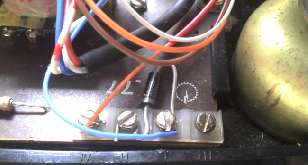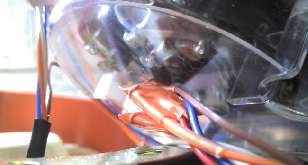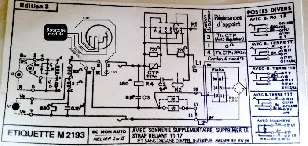Rick's b.log - 2011/07/17
You are 18.191.237.228, pleased to meet you!
Rick's b.log - 2011/07/17 |
|
| It is the 21st of November 2024 You are 18.191.237.228, pleased to meet you! |
|
mailto: blog -at- heyrick -dot- eu
Okay. So, yes, a friend came to visit. A real three dimensional friend! ☺
He took the EuroStar into Paris, then the high-speed TGV to our nearby "big town", then the dinky little TER train (that around here runs on a single rail, but then there's only something like six trains a day). The first night was spent in a hotel that it more motel-like. A bed, a telly, a shower/toilet. Functional and not horribly expensive.
We met up on Saturday, Mick came back chez nous and my mother and I talked about all sorts of stuff until eleven at night. At which point mom retired for the night, and we geeked out until quarter past three. But as Mick said, even if we had a week, there wouldn't be enough time!
I tried him on a (small) variety of products, such as Sweet Sakura tea and little bean-paste cakes. All were appreciated.
We put up my tent in the evening, which was really simple (snap together three rods, insert them, peg the shell to the ground, suspend the inner part - it's a fifteen minute job for one person), so he retired to the tent for the night.
Next day, we all went to a "fête du mouton", a festival of sheep which for some reason had a giant sheep pulled by a tractor - I can't help but think of that film with the zombie sheep...
Back near the h
I wish Saturday night I could have stopped time. It was great to listen to, and speak to, somebody on my wavelength. We could have gone all night. Well, I don't know about Mick, but I could have gone all night!
Yes, bottled water. The stuff in the taps is well water. We don't drink that!
At any rate, the rice cooker now bubbles a little bit, but is nowhere near as lively. And, as always, the rice is beautifully cooked in maybe 25 minutes. I just add two measures of water for every measure of rice, plug it in, let it get on with it.
For those who eat a lot of rice - I would class a rice cooker as essential. If you're only thinking of rice, then a simple one would suffice (mine cost a mite under twenty euros!), though more advanced models can do porridge, cakes, and so on.
Direct comparisons are difficult, for Satsuki stocks a lot of stuff the average supermarket doesn't. However, what is stocked can be interesting. Remember that Satsuki is an internet-based company run by a man and his wife, while a supermarket is part of a big chain with "buying power" to ensure the best prices for there customers.
1. Yakitori sauce
I guess the moral here is fairly certain - while it might seem like a small on-line shop is more expensive than the supermarkets, you might find yourself in for some surprises.
Apparently some ADSL boxes can function with loop disconnect (pulse) phones. The Livebox isn't one of them, but then this is no surprise given the Livebox's USB port does nothing - it's all down to half-assed unfinished firmware. Meh. Anyway, all is not lost. We just need a device that reads the ticks of the dialler and emits the appropriate tones. The Rotatone is just such a clever device. The only complication is in getting it into the phone. For this, we need to have a vague idea of how the phone actually works in order to know where to fit it all.
The inside of the telephone was fairly clear, aided by a schematic stuck to the inside of the casing. It never ceases to amaze me how the telephone network functions, such powerful simplicity.
Astuce! [that's French for "tip!"/"hint!"]
Here is the schematic of the telephone:
The first step was to patch in a bridge rectifier to convert the phone to DC. This is because the phone system is normally polarity inspecific, however our Rotatone module needs a specific polarity in order to function.
The next part was to fit a Zener diode. This helps ensure that sufficient voltage is shunted through the circuit to allow Rotatone to function - old carbon microphones might have a sufficiently low resistance that this may not be the case, hence the Zener, a 5.1V type
The four terminals for the dialler are where the Rotatone taps into the phone for power. The Orange/Red being the positive supply and the Blue being the negative/0v line. The Rotatone also uses these connections to inject tones into the line by altering its current consumption. Recall, a telephone circuit is basically a big current loop (the current is important, the actual voltages present are not) where modulations in the current are the signal. This also explains how you can run a fully duplex system (both people speaking at the same time) using only two wires. Like I said, it's a marvellously clever system.
The final part is to remove the dial unit from the circuit, and hook it to the Rotadial module. There are three wires and the Rotadial, and four dial contacts. Essentially the rotary dial works as follows:
For what it is worth, the rotary dial unit is a marvellous thing too. If I can pick up another phone cheap at a vide grenier, I'll take the dial unit apart and show you.
All back together and reassembled, I called my mobile. The first time failed, told me the number was unknown. The second time worked. It seems the secret is to know the number well so you can dial it off quickly with no messing around. There is also a quirk that this particular type of phone operates with a 66ms/33ms timing, which isn't helped by age and wear affecting the governor which will affect the timing. If this turns out to be a problem, I'll need to warm up the screwdriver and do a hardware mod to tweak the timing.
Ringing the phone back, it didn't ring. I don't know if the Livebox's VoIP chip is too weak to activate a mechanical ringer, or if it's just a screw-up in my wiring. I suspect the latter. I might need to remove the strap between the outer two contacts of the line (see the topmost inside-the-phone picture) and put one of the AC lines here in order to pass AC through to the bell, as for the moment there is no longer any AC in the phone.
The after-mod schematic is:
If you want a ridiculously detailed guide to how the POTS works, this French guide has it all http://www.scribd.com/doc/36685087/RTCP
In English, the first few pages of http://www.scribd.com/doc/19630759/Basic-Telephony describe how the phone works, but being an academic paper it then goes on about system load predictions and such, rather than the nuts and bolts about how it works. Seriously, even if French is alien to you, load up and browse through the RTCP document. There's enough there in the diagrams - it's a shame I can't find the same thing in English as that RTCP document is brilliant.
Mick's visit
Well, it's a week ago that we left Mick at his hotel. It doesn't seem like a week ago!

Associated, a massive vide grenier which I think Mick quite enjoyed given there was a lot of vinyl. In fact, I've never seen so many disques in one place!

^Hmotel, Mick treated us to a meal. Then we did the whole goodbye thing with nowhere near enough covered - dammit we didn't even get to warm up the compiler!

Rice maker redux
Lots of thanks to Nikko and Akemi for suggesting that I wash my rice a little more vigorously before cooking. So rather than washing some water through it, I use a strainer and shake it while passing two litres of bottled water.
Akane
For my birthday, mom got me a little money-box. I call her Akane (a-ka-nay) which means "deep red". Seems appropriate.

Satsuki vs the giants
I was speaking to the guy that runs Satsuki (where I get a lot of my Japanese niceties), and he said that while he has noticed the English supermarkets often fight each other (Asda vs Tesco price-watch adverts, anyone?), it isn't really in the French psyche to behave like that.
Therefore...
Or maybe not.
 Try €3.95 for the exact same thing.
Try €3.95 for the exact same thing.
2. Rice
 This is €2,23 for 500g of special sushi rice.
This is €2,23 for 500g of special sushi rice.
Not a bad rice, until you consider that I can get a kilogram of rather nice rice for €3,47 (which is €1,73/500g).
A fiver will get me a kilo or organic, and a little over a tenner will get me authentic actually-made-in-Japan rice in a 2kg bag (works out at around €3/500g which is marginally more expensive, but it's the real deal).
3. Noodles
 The Nissin range is a comparable price, the Oyakata range is around €1,50. Either way, there are many flavours to choose from. Unlike a "generic three" shown here.
The Nissin range is a comparable price, the Oyakata range is around €1,50. Either way, there are many flavours to choose from. Unlike a "generic three" shown here.
Take a look.
Personally, I will continue to use Satsuki because it offers the stuff I'm interested in, the product range is expanding (they've recently added a selection of organic products), and I'm unimaginably annoyed that my U is replacing more and more stuff with own-brand. How's about a choice, huh? Oh, wait, sorry - my mistake. The big companies exist to ride the tails of what is "trending" and tell us what we want... kinda sounds like [fires up Deezer] the music charts.
What I'm listening to while writing this...
Thanks to Deezer, lots of songs on tap. So I'm listening to this - but note, it is not a happy song. And it isn't Japanese either, it's in English. It's a beautiful, tragic song. I like songs like this. Don't know why, but I know that most love songs make me want to vomit (at least with foreign music, I don't know how inane the words are ☺). Such amazing orchestration for a group better known for (ab)use of the electric guitar.
Dial-phone goes beepy
Click to Google-translate this into French. [or, for the hell of it, Japanese!]
 One of the things Mick brought over with him is a little module called "Rotatone" that he got from eBay. It is intended to hook into my old-fashioned phone (a Socotel S63) to translate the dial pulses (which don't work with VoIP connections) into tones (which do).
One of the things Mick brought over with him is a little module called "Rotatone" that he got from eBay. It is intended to hook into my old-fashioned phone (a Socotel S63) to translate the dial pulses (which don't work with VoIP connections) into tones (which do).
Note that my ringer doesn't, so consider this a work-in-progress!
Indeed, the Socatel (that stands for Société des Constructeurs de Téléphones) is clear and concise inside. The rotary dial unit is a marvel to look at if <cough> you're into that sort of thing. ☺
For testing your wiring and connections, plug your phone into the France Télécom master socket. Don't worry if you don't actually have a real phone (i.e. you're dégroupée with only VoIP), the analogue socket still functions, only you can't call out on it. You'll hear the out-of-service beeping and possibly the ADSL squeaking. It'll be sufficient to test the earpiece works, and the pulse-to-tone functions.
I suggest this as the POTS is quite robust (kilometres of strung lines with interference, risk of lightning, etc) so if you do something dopey like short the A and B then it's no big deal. At any rate, it'll be better than risking screwing up your ADSL box, no?


1N5338B. The Zener is fitted seemingly backwards to it 'breaks down' at 5.1V and permits this to pass, in other words forcing at least 5.1V through the circuit.

When the unit is at rest, the DP (dial pulsing) contact is open, and the LD (loop disconnect) [pulse] contact is closed. This allows current to pass through the phone, so it works.
You can see what is going to happen here, can't you? The Rotadial's white wire connects to the common connection in the dial unit. The DP is connected to the brown wire to signal to the Rotatone that a dial is imminent. And finally the LD connection is the orange wire.
When a user begins to dial, and for all the time the dial is not at rest position, the DP contact is closed, shorting the earpiece so that the user doesn't get a horrible clicking in their ear.
To actually dial, the dialling is managed during the release of the dial. This is because fingers are an unreliable way of making pulses, so instead the action of pulling the dial around "charges up" a spring, and upon release a governor restricts the speed of return (this gives the familiar eheheheheh sound). Upon the controlled release, a cam is activated to pulse the LD contacts. The behaviour this has is akin to hanging up and then picking up the handset, only at a rate of about ten times per second.
Yes, it was entirely possible to 'fake' pulse dialling by tapping the switch that hangs up. This was a favourite at boarding school for when we wanted to make calls but didn't have money (but the damn all-in-one-style phone fixed that, meh).
That extra switch? Not necessary, ignore it. Look to the right side of the schematic, you'll see different types of circuit require different configurations. In its default (all connected) state, it looks like it shorts across the microphone? Perhaps to protect it against current transients from dialling? Remember the on-hook current is around 48V so the act of dialling may send some crazy-scary voltages flying around inside the phone... if you're an itty-bitty carbon mic. ☺

I'll look at this another time. For now, the dial unit is successfully converted to be tones, and now an old lump of a phone from the '60s (I think?) works with a modern VoIP service. Yay!

Nyaa! <3
Guess who is seven years old today, and still a little furry ball of cuteness!

Rick, 1st June 2023, 19:44
| © 2011 Rick Murray |
This web page is licenced for your personal, private, non-commercial use only. No automated processing by advertising systems is permitted. RIPA notice: No consent is given for interception of page transmission. |